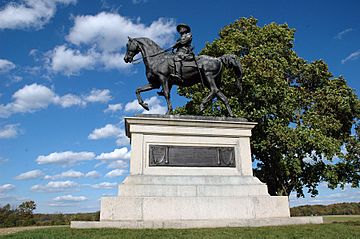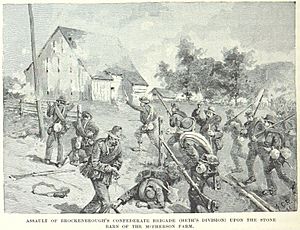McPherson Ridge facts for kids
Quick facts for kids McPherson Ridge |
|
|---|---|
| Middle Ridge | |

Gettysburg Battlefield monuments on McPherson Ridge (north-northeast view) include the
1899 John F. Reynolds equestrian statue. |
|
| Highest point | |
| Peak | northernmost point: saddle point at Oak Ridge near the intersection of Reynolds (and Wadsworth Avenues.) |
| Geography | |
| Location | 1858 Dustman barn |
| Country | United States |
| Township & NPS unit |
Cumberland and Gettysburg NMP |
| Range coordinates | 39°50′13″N 77°15′05″W / 39.8370°N 77.2514°W |
| Parent range | "outcrop of the Gettysburg sill" |
McPherson Ridge is a special place in Gettysburg, Pennsylvania. It was a very important location during the first day of the Battle of Gettysburg in 1863. The Union Army's First Corps had its main base here. However, they were defeated by Confederate soldiers led by Major General Henry Heth.
Today, McPherson Ridge is mostly a protected area. It is part of the Gettysburg National Military Park. This park helps remember the history of the battle. The ridge is about 530 feet (160 meters) high. Some parts are even higher, reaching over 560 feet (170 meters).
History of McPherson Ridge
McPherson Ridge has a long history, even before the battle. In 1747, a road called the Nichol's Gap Road was built over the ridge. This road is now known as Fairfield Road. Later, in 1809, another road was built to Chambersburg.
In 1835, a railway cut was dug through the ridge. This was for a railroad project called the Tapeworm Railroad. By the 1850s, more roads crossed the ridge. Farms also started to appear. The "H. Dustman" farm was on the ridge. The "McPherson" farms were also located here.
In 1858, a lawyer named Edward McPherson inherited a farm on the ridge. His farm was about 66.5 acres (27 hectares) by 1863. Just before the Battle of Gettysburg, on June 30, 1863, Union cavalry soldiers camped near the ridge. They were led by John Buford.
The Battle of Gettysburg
The Battle of Gettysburg began on July 1, 1863. Around 8 in the morning, John Buford's 3,200 cavalrymen fought on McPherson Ridge. They were on foot and held off 7,000 Confederate soldiers. They fought bravely until 10:30 am. That's when more Union soldiers arrived to help.
Later, the Union forces had to move back to Seminary Ridge. During the battle, Confederate soldiers attacked a large barn on the ridge. Many Union soldiers had taken shelter inside. The barn was captured and then used as a field hospital for injured soldiers.
After the war, in 1869, a "Horse Railway" was built over the ridge. This was a train pulled by horses. Later, in 1884, a steam train railroad was extended through the railway cut.
Many monuments were built to remember the battle. In 1886, a monument for John F. Reynolds was put up in Herbst Woods. In 1887, land on the ridge was sold to create an avenue for visitors. A special "Platt Truss Bridge" was built over the railway cut. The ridge became known as "McPherson Ridge" by 1892.
Gettysburg National Military Park
The Gettysburg National Military Park was created to protect the battlefield. In 1895, a law was passed to make the park official. More land on McPherson Ridge was added to the park over the years. For example, in 1900, 40.47 acres (16.38 hectares) of "Reynolds Woods" were added.
New roads were built for visitors. Stone Avenue was built in 1902. Meredith Avenue was also added by 1904. On December 24, 1904, the park bought another 36.56 acres (14.8 hectares) on the ridge.
In 1913, the Chambersburg Turnpike became part of the famous Lincoln Highway. Later, in 1927, the Hagerstown Road became Pennsylvania Route 116. The National Park Service built a new entrance station for the park in 1937. It was made of local stone. The old bridge over the railway cut was replaced in 1958.
Today, monuments on McPherson Ridge are important historical structures. They help us remember the brave soldiers who fought there.


